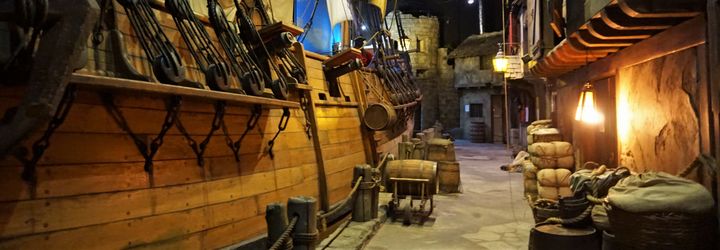
The Queen Anne’s Revenge, Blackbeard’s flagship in the Pirates of Nassau Museum
“Are ye a pirate, sir? Well then, sign aboard,” says the man in the tricorn hat, brandishing a flintlock pistol as he beckons visitors into the Pirates of Nassau Museum. Called “the best pirate attraction in the world” by British pirate historian David Cordingly, the museum in downtown Nassau, Bahamas, blends some Disney-like effects with enough real history to offer a fun look at the pirates who ruled the waters of the Bahamas 300 years ago.

Entrance to the Pirates of Nassau Museum
And what a story it is. During the “Golden Age of Piracy” (1715-1725), the greatest conglomeration of pirates the world has ever known assembled at Nassau and created an actual Pirate Republic that terrorized the Americas and even challenged the European powers of Britain, France and Spain. They were all here – 2,000 outlaws including Blackbeard, Black Bart, “Calico Jack” Rackham, Charles Vane, the women pirates Anne Bonney and Mary Read and dozens of others, all with one thing in common: they were loyal to no country and an enemy to all.
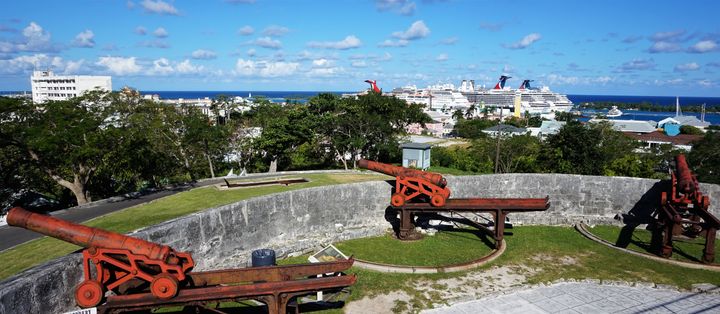
Cannons at Fort Fincastle and at Fort Nassau, which has disappeared, once protected pirates in Nassau from heavy warships.
But these pirates were a lot different than most people think. Formerly, they had been privateers, loosely fighting for England, France or Spain. But when the wars ended in 1715, they had no occupation and little choice but to turn to piracy. At this time, the world was ruled by kings, but the pirates in the Bahamas were revolutionaries and they created their own republic -- a democracy where they elected their own captains and officers. Runaway slaves were treated as equals and nearly a third of the crew on some pirate ships were free blacks. Pirates had their own laws and courts and even offered the first naval disability program to anyone injured in battle. But the real allure was best summed up by pirate Captain “Black Bart” Roberts, who said of pirating, “It was a short life and a merry one.”

Holland America’s Nieuw Amsterdam
And so was my four-day Holland America cruise on the good ship Nieuw Amsterdam, bound for these same pirate waters of the Bahamas from Fort Lauderdale. I have always loved pirates, so why not take advantage of some excellent December cruise prices to sail the historic pirate-infested waters and visit the haunts that have inspired hundreds of films, books and legends. I would devote the cruise to all things pirate – visit a private island once used by pirates to collect water, see the famous pirate museum, visit old forts, take a pirate history walking tour (sponsored by a brewery, of course), drink some rum, eat like a pirate and stroll the colonial backstreets of Nassau, taking in many of the same views over the island that Blackbeard and Black Bart had once known.
“Life on board a pirate ship consisted of long periods of drunken idleness and brief periods of violent action…Most of their time was spent gambling and drinking huge quantities of alcohol.” — Placard in the Pirates of Nassau Museu
Well, pirates never sailed on the Nieuw Amsterdam. Oh, you could get drunk, easily enough, and there was gambling once outside the 12-mile U.S. border. But it was hard to be idle with so much to do on board the ship, not the least of which was to take in the sunset and beautiful views of the sea – the same exact view that pirates would have seen. Technically, the Bahamas, just 180 miles off the Florida coast, are in the Atlantic, not the Caribbean. But the sea has the same sparkling aquamarine blue color of the Caribbean, with idyllic sandy beaches lined with palm trees.
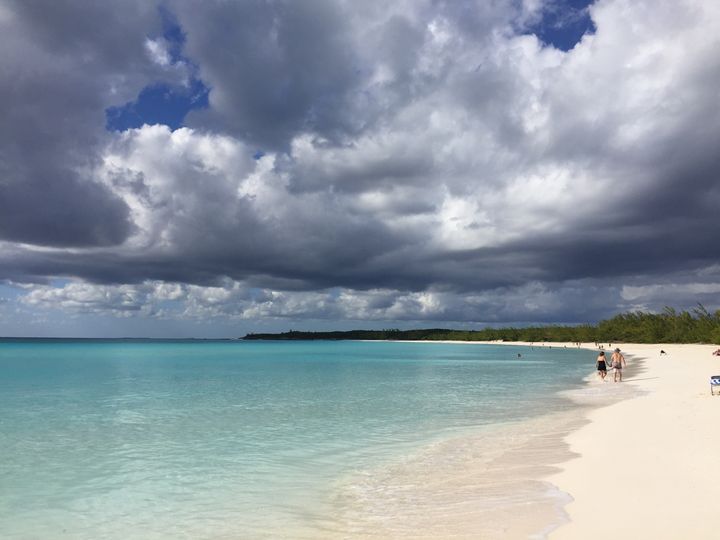
The private island of Half Moon Cay.
From here, armed to the teeth in fast sailing sloops, the pirates could venture out into popular sea lanes to prey on Spanish treasure ships and British and French merchantmen. The first indication the victims would have of danger approaching would be to see the Jolly Roger flapping in the breeze on the horizon – the dreaded pirate flag. The idea for the flag most likely came from French pirates, who would soak a white flag in blood to let their victims know they would be treated with no mercy. These flags were called “le joli rouge” – the pretty red – which drunken English pirates translated into “Jolly Roger.”
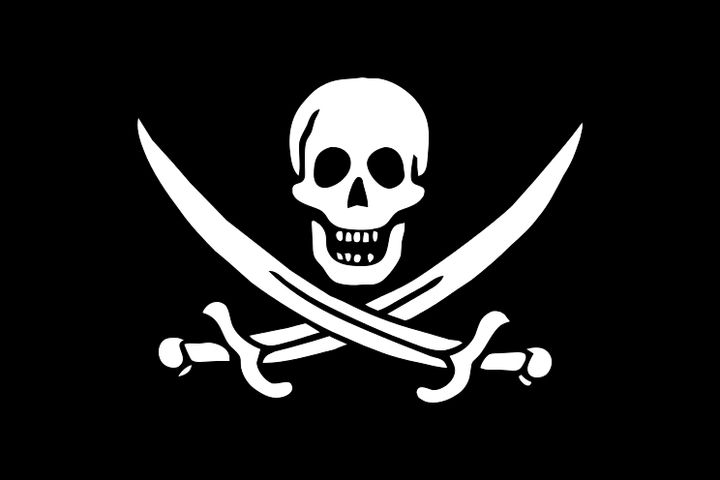
The Jolly Roger of Calico Jack Ratham
Each pirate crew hired seamstresses in Nassau to create their own flag, which generally had a skull and crossbones, death head, crossed sabers, bleeding hearts or an hourglass to show the victims that their time was up. Pirates never actually liked to fight. It was dangerous, and it could damage the ship they were trying to seize. So they liked to employ terror. Blackbeard would tie burning fuses into his beard and hair so that he was surrounded by smoke and looked like a fiend from hell, which he also just happened to resemble in temperament and cruelty.
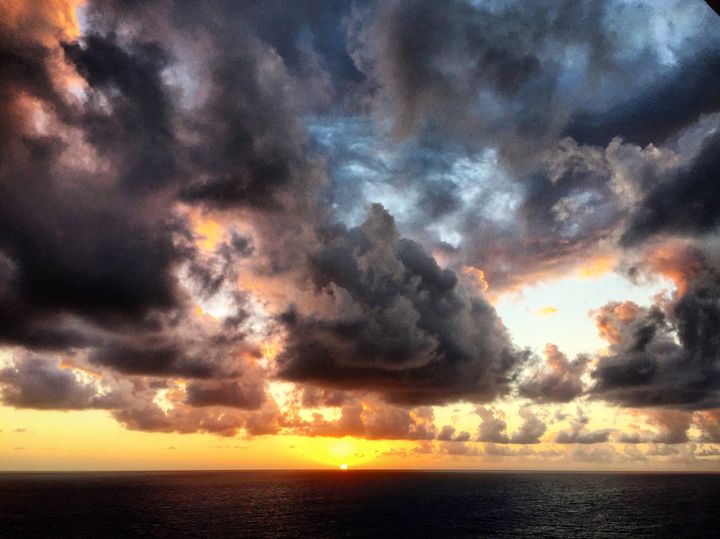
Sunset at sea aboard the Nieuw Amsterdam bound for the pirate waters of the Bahamas
On my first night at sea, there being no Jolly Rogers in sight, I spent my time in drunken idleness, but on the morrow, we were tied up off shore before the private island of Half Moon Cay, as pretty an island paradise as ever held a buried treasure chest. Of course, as I was to learn, with the one exception of Captain Kidd, pirates never buried treasure. That (and much of what we think we know of pirates) was invented by Robert Louis Stevenson in his classic book, “Treasure Island.”
Most pirates were alcoholic wastrels who would spend their loot in one night of drunken passion in Nassau, or gamble it away, and soon end up back living in a broken down hovel, waiting for the next adventure. The majority of them were in their 20s, and lived short, violent lives. Not a single pirate captain of the era had his life end naturally, most of them being hanged, shot, or killed in storms. Or they went out in a blaze of battle, like Edward “Blackbeard” Teach, who died from five bullet wounds, 20 stab wounds and was beheaded.
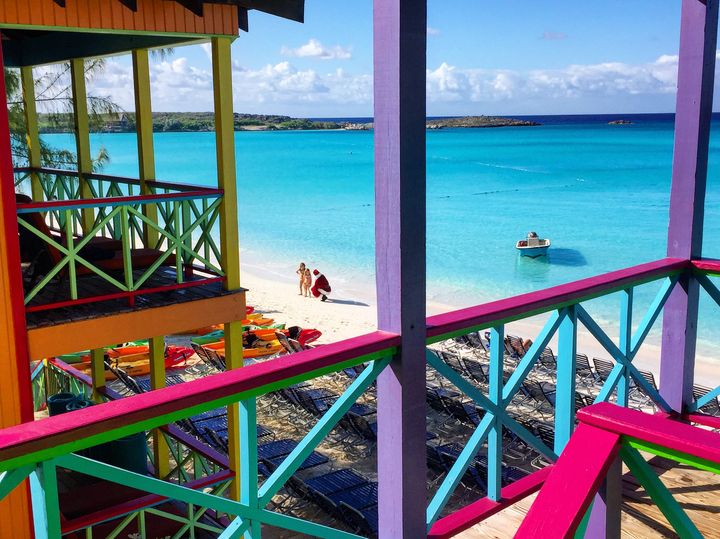
Half Moon Cay
Half Moon Cay, where we dropped anchor, is its own pleasure palace with every opportunity from jet skis and kayaks to horseback riding in the surf, glass bottom boats, biking, paddle boarding or just lounging on the beach. I elected to take a nature hike to the summit of the island, some 68 feet high, passing ruins of old farmsteads along the way. There are 700 islands in the Bahamas and pirates would use ones like this to gather water and food, and lay in wait for a plump merchantman passing by. Or to maroon pirates. Marooning on a deserted island was a common punishment, and a cruel one. Although it might seem like a pleasure today, the lack of food and loneliness made it a misery for those left behind.
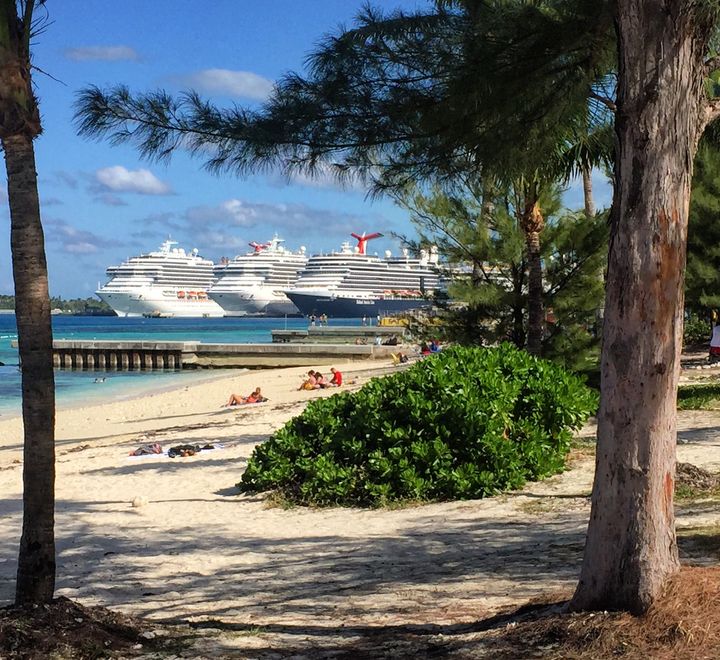
The harbor of Nassau, Bahamas
Our next morning, we sailed and docked in Nassau, just a musket shot from the Pirate Republic Brewing Company. With fresh beers on tap with names like Long John Pilsner and Black Beer’d Stout, this is general headquarters for pirate memorabilia in Nassau, and their shop is filled with pirate stuff, from skull and cross bone kitchen magnets to the all-important pirate bandanna. The brewery offers a combination pirate and beer walking tour for $13, which ends with a sampler tray and a giant pretzel. Around the stone walls of the 125-year-old pub are commissioned portraits of all the famous pirates of Nassau, created by renowned Bahamian artist Antonius Roberts.

Pirate guide on the Pirate Republic Brewing Company pirate and beer tour
The art provides a backdrop to tell some of the crazy stories of people like pirate Howell Davis, who “died like a game cock,” killing two men before he fell, and “Calico Jack” Rackham, who was probably the pirate closest to Johnny Depp’s Captain Jack Sparrow in the Pirates of the Caribbean films.
While in Nassau, Calico Jack fell in love with Anne Bonney, and convinced her to leave her husband, put on men’s clothes, steal the sloop Sweet William and begin a life of piracy. Incredibly, once at sea, Anne fell in love with a fellow shipmate, only to discover that this pirate was also a woman dressed as a man – the adventuress Mary Read. The three sailed together as pirates until they were surprised by a British ship off the coast of Jamaica. Calico Jack and most of the crew were drunk and hid in the ship’s hold. Only Mary Read and Anne Bonney offered any resistance, fighting like hellcats with pistol and cutlass. But the ship was taken and all three sentenced to hang. As Calico Jack went to the gallows, Anne told him, “Had you fought like a man, you need not have been hanged like a dog.” Anne and Mary both conveniently got pregnant in jail and escaped the hangman.
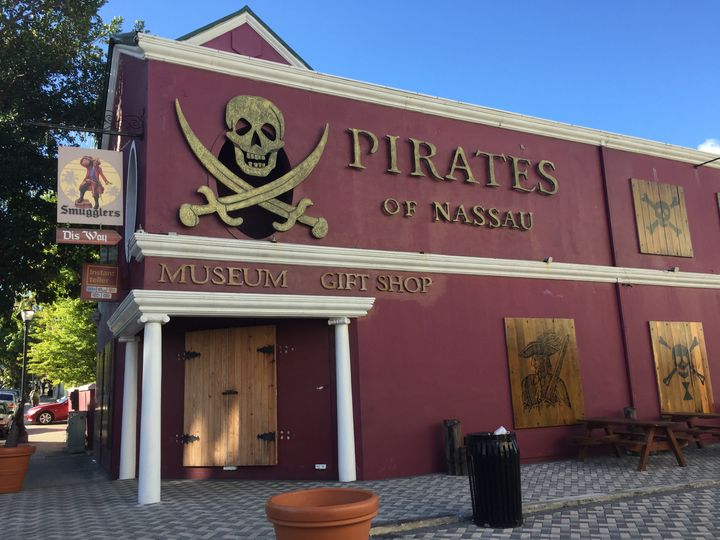
Pirates of Nassau Museum
But many other pirates didn’t. Just a cannon shot from the brewery is the block long Pirates of Nassau Museum. As you walk by two fortress cannons into the front door, you plunge straight into a moonlit dock lined on one side by taverns and pubs and on the other by a full-scale reproduction of the 130-foot-long, 16-gun corvette, The Queen Anne’s Revenge, Blackbeard’s flagship. It’s like walking (instead of floating) through Disney’s Pirates of the Caribbean ride. Sound effects replicate the creaking of the ship and the lapping waves hitting the dock, while you can hear pirates singing in the dimly lit pubs beside you. If you’ve just come from a beer sampling (and had a couple shots of rum along the way) the illusion is very entertaining.

Life size dioramas depict important moments in the history of Nassau pirates, like this meeting of the women pirates Anne Bonney and Mary Reed with Calico Jack Rackham
The museum details a pirate’s miserable life at sea and how the whole pirate era finally came to an end. Tired of the nuisance, England sent Woodes Rodgers (a former pirate himself) to Nassau in 1718 with three warships and an ultimatum for the pirates to choose: “Accept a pardon….or death.” In short order, most accepted the one-time offer of a pardon, and Rodgers cleaned up the rest, hanging ten of them at Fort Nassau. He described his actions as: “Expulsis Piratis – Restituta Commercia,” words that still adorn the official seal of the Bahamas – “Pirates Expelled – Commerce Restored.”
Ironically, it’s the pirates who have remained heroes. You can’t throw a cutlass in Nassau without hitting a shop selling skull & crossbones t-shirts or “Got Grog?” bumper stickers, while the only tribute to Rodgers the pirate hunter, is a small statue of him reaching for a brace of pistols, located in front of the British Colonial Hilton Hotel. He looks angry. But at least he looks dashing. The real Rodgers, when he was a pirate, got shot in the face, blowing away his jaw and many of his teeth and it’s doubtful he looked as handsome as he does here.
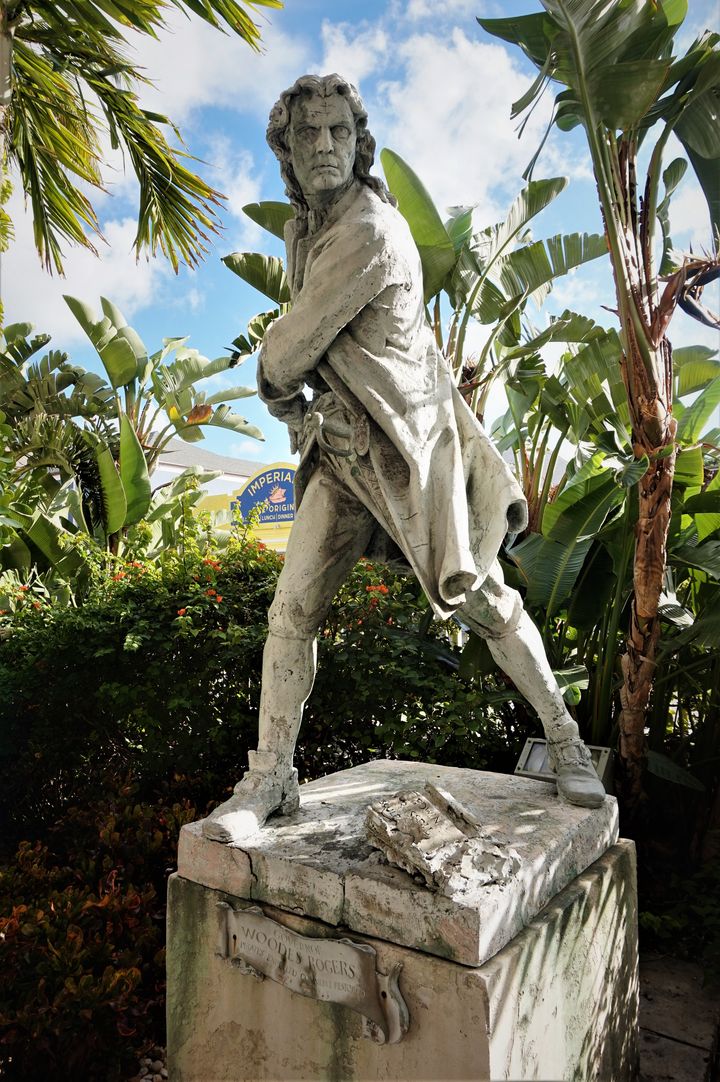
The statue of pirate hunter Woodes Rodgers
Strangely enough, the British Colonial Hilton is the very spot where Rodgers hanged his ten pirates. And it’s also where James Bond stayed in the Ian Fleming book, Thunderball, which is about a modern day pirate in Nassau high jacking an atom bomb for ransom.
If you want to eat like a pirate, walk down Bay Street from the hotel for about a mile to a village known as “Fish Fry.” This is a row of a dozen local seafood restaurants, where the meal of choice is conch…a snail-like, beautiful pink shell mollusk that tastes like a rubbery scallop and can be grilled, stewed, fried or served cold in a conch salad with green pepper, tomato and onion, cured in lemon juice. “Cracked conch” (conch fried in a light batter) with “peas and rice,” (rice and small beans) and fried plantains (small banana-like fruit), washed down with the very drinkable local beer, Kalik, is the national dish.

Cracked Conch and peas and rice
Kalik is brewed in the Bahamas and the name is supposed to come from the noise cow bells make. Well, why not? Lonely Planet will tell you not to eat conch because of its near endangered status and the fact that is quietly being fished out in the Bahamas. Conch from the Bahamas has already been banned in the U.S. since 1986 and many other Caribbean islands. But as a pirate, how could you not taste the national dish? Conch is an important part of the Bahamian diet and a major source of their protein. It’s also delicious.
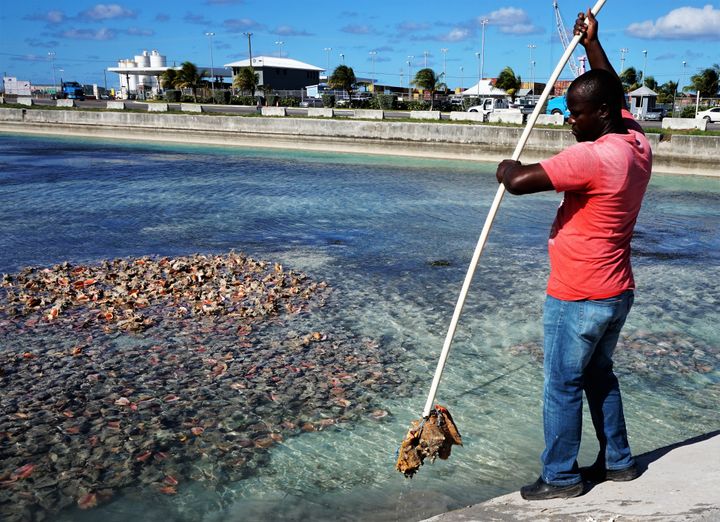
Pulling conch out of the sea, where it is kept alive until serving
For fun, stop at D’Water Café at Fish Fry for the Big Daddy Conch Show. Big Daddy (the rather large gentleman with no front teeth) has been cracking conch on the restaurant’s front porch for decades and will show you how it’s done with a hammer and knife. “If you want it any fresher, go and catch it yourself,” as they say. Though if you walk to the back of the restaurant, you can watch them pull fresh ones out of the water. Experts say it’s kindest to only eat mature, six year old conch, and Big Daddy will help you find one. As a pirate, you can finish off the meal with a fine Cuban cigar – legal and cheap in Nassau, but of course illegal to bring home to the U.S.
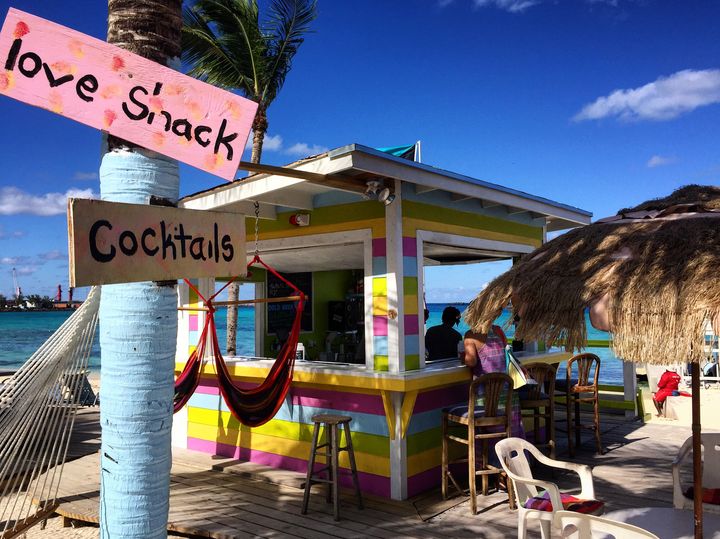
Nassau, across the harbor from Paradise Island
And if you still want more pirates, just look across the harbor to what was in pirate days called Hog Island. Today, thanks to some splendid PR marketing, it’s called Paradise Island. At one time, the majority of this island of resorts and golf courses was owned by the biggest pirate of them all. A scallywag named Donald Trump.
For more information: Holland America
